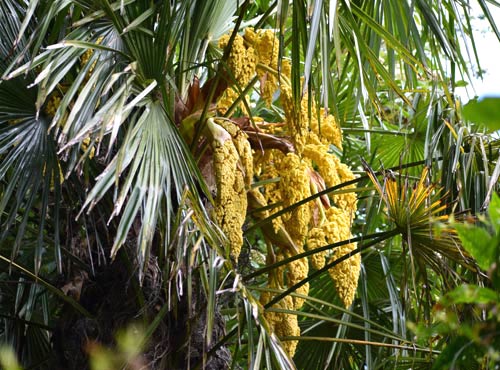We regularly recommend the people of Thurles and their temporary elected public servants to focus their gaze more upwards these days, away from their mobile phones screens.
Reason being that the public can more readily view how taxes from hard earned income is being wasted, e.g. 29 street lights burning 24 hours each day, 24 of them for over 3 months.
For all you flower lovers out there, I am happy to relate that there is now another reason to stand and stare skyward. Yes, the “Trachycarpus fortunei” or “Chinese windmill palm“, has burst into bloom here in Thurles.

Also known as “Chusan palm“, this solitary 45 year old, 25ft hardy evergreen palm tree, in the family Arecaceae and native to parts of China, Japan, Myanmar and India, can be viewed in all its glory in O’Driscoll’s Garden Centre, latter situated on the Mill Road, east of the town centre and well know, throughout Ireland, as the home of rare plants.
The tree is a single-stemmed fan palm which can grow between 12–20 m (39–66 ft) high with a trunk diameter of 15–30 cm (6–12 in). Each leaf is 140–190 cm (4 ft 7 in – 6 ft 3 in) long, with the stalk that connects the blade with the leaf base (petiole) some 60–100 cm (2 ft 0 in – 3 ft 3 in) long, and the leaflets up to 90 cm (2 ft 11 in) long.
The flowers, as the picture shows are yellow (male) and greenish (female), measuring about 2–4 mm (3⁄32–5⁄32 in) across, borne in large branched panicles up to 1 m (3 ft 3 in) long in spring; with male and female flowers produced on separate trees (dioecious). The fleshy fruit is of a yellow to blue-black, kidney-shape, with thin skin and a central stone containing the seed 10–12 mm (13⁄32–15⁄32 in) in length , which ripens in mid-autumn.
One of the hardiest of palms, “Chinese windmill palm” has been cultivated in China and Japan, for thousands of years for its coarse but very strong leaf sheath fibre, used in the making of rope, sacks, and other coarse cloth where great strength is important.
The species was first brought from Japan (Dejima) to Europe by the German physician Philipp Franz von Siebold * in 1830. Its more common name, “Chusan palm” refers to Chusan Island (now Zhoushan Island), where Robert Fortune first saw cultivated specimens.
* Philipp Franz Balthasar von Siebold (1796 – 1866) was a German physician, botanist and traveler. He achieved prominence by his studies of Japanese flora and fauna and the introduction of Western medicine in Japan. He was the father of the first female Japanese doctor educated in Western medicine.
In 1849, Robert Fortune * smuggled plants from China to the Kew Horticultural Gardens, London and the Royal garden of Prince Albert, East Cowes, Isle of Wight, United Kingdom, hence the later name Trachycarpus fortunei, after Robert Fortune.
* The Scottish botanist Robert Fortune was also commissioned by the East India Company to steal tea from China; one of the greatest heists and pieces of corporate espionage carried out in human history, that resulted in dislodging one monopoly and establishing the British East India Trade company, as the largest producer of tea.

Leave a Reply